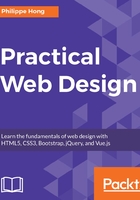
上QQ阅读APP看书,第一时间看更新
Conventions used
There are a number of text conventions used throughout this book.
CodeInText: Indicates code words in text, database table names, folder names, filenames, file extensions, pathnames, dummy URLs, user input, and Twitter handles. Here is an example: "Let's create this folder and call it Racing Club Website."
A block of code is set as follows:
<html> <!--This is our HTML main tag-->
<head> <!--This is our head tag where we put our title and script and all infos relative to our page.-->
<title>My Page Title</title>
</head>
<body> <!--This is where all our content will go-->
<h1>John Doe</h1>
</body>
</html>
When we wish to draw your attention to a particular part of a code block, the relevant lines or items are set in bold:
.content {
background-color: red;
width: 75%;
}
.sidebar {
background-color: green;
width: 25%;
}
Bold: Indicates a new term, an important word, or words that you see onscreen. For example, words in menus or dialog boxes appear in the text like this. Here is an example: "then click on the three dots at the right-hand corner and click on Show device frame."
Warnings or important notes appear like this.
Tips and tricks appear like this.